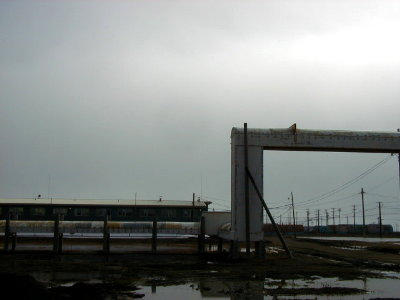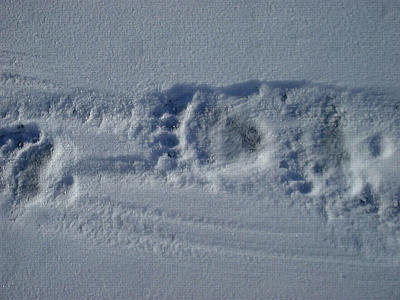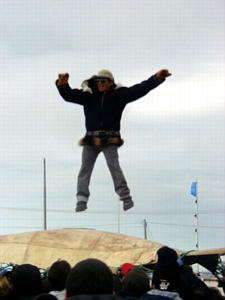
|
|
22 June, 1999
Tuesday, June 22nd, 1999
Contents: answering questions
Guest speaker: Steven Brooks, Atmospheric Researcher
Pictures: baleen and driftwood "palm trees"/Pigniq (shooting station).
Hi everyone! I am happy to finally hear from you, Wai'anae! Also, I
received the CU-See Me videoconferencing software in the mail, so I will
try and get that all connected yet tonight so we can see each other before
I have to leave. Time is going quickly - my plane back to Fairbanks is
July 1st (next Thursday)!
Great questions, everyone - I have had to check around for some of the
answers, so you are keeping me busy!
From Robin: Do they get much fruit and vegetables in Barrow?
-------Yes! At the ARF (Arctic Research Facility), where I am staying, we
have had peaches, apples, oranges, bananas, mangoes (my addition),
asparagus, squash, broccoli - pretty much anything you can get anywhere.
The difference is in the prices! Many things at the grocery store, or
"stuaqpak" (sounds like stock - pot, with a k instead of a t at the end)
are priced according to their weight, as they must be shipped in. So some
things are not expensive at all, while other things, like a gallon of milk
($7.00), really add up the grocery bill.
Some prices to compare: Melons 2.39/lb
oranges 1.99/lb
apples: 8.89/5lb bag
bananas 1.89/lb
grapefruit 2.19/lb
nectarines 4.99/lb
From Tiana: Have you seen any polar bears?
-------Nope, not yet! We haven't been carrying guns out on the tundra,
since there hasn't been any sightings around recently. Everyone who works
for USFWS (United States Fisheries and Wildlife Service), which is
basically everyone who is on the project I am helping with, carries "Bear
Spray", which is like pepper spray, which might annoy them enough to keep
them from attacking you. There were bears out on the ice today, but I
didn't see them. One of the visiting scientists from China saw three.
Many people who work counting the whales as they migrate past Barrow
(the whale census crew) have seen their fair share of polar bears. They
wander into their camps, since they are camping out on the ice, at the edge
of the open water (called a "lead"). For most of the year, Barrow has
"shorefast" ice, which is ice that connects on to shore - it is still
present now. The shorefast ice can go out for miles, but just yesterday I
began to see a strip of blue, blue water beyond. That is the "lead", or
open water. People camp right out there on the ice, by the lead, in order
to either count the whales, or to hunt the whales, depending on whether you
are a subsistence hunter or a wildlife biologist! Polar bears sometimes
get trapped on land, when the lead opens up, and they are on the the
shorefast ice! Then they come onto shore, looking for food. I might
have a better chance of seeing a polar bear in person later on this week,
as I have a chance of going out and camping on a little barrier island
about 12 miles off shore during this weekend. There is a scientist there
who comes every year and spends time looking at a colony of seabirds - he
knows them like they are part of his family now! Since that little island
is off shore, polar bears are more likely to be around. Then it is
important to have a gun around, although you only want to shoot it if your
life is in danger! Sometimes, people can scare them by shooting the ice
right in front of their feet, so the ice kind of explodes in their face.
If people do this often, though, the bears get used to it and it doesn't
work anymore!
From Tiara-Marie: What is the coldest it has gotten while you are there?
-------- The coldest it has been during the 12 days I have been here is
somewhere in the 20's. Definitely cold for Hawaii, but not to bad for me
since I was raised in Minnesota! Like Minnesota, the real problem is not
the temperature, but the windchill! The wind makes everything feel much
colder. Windchill might be something you talk about in your class.
From Keoni: What do you do for fun?
------- Good question! I write to you guys, for one thing! Since the field
season in the Arctic is so short - the snow is just leaving now, and
everything will start icing up again by September or October - it is really
important to get all the research that needs to take place on the tundra
done as fast as possible. So everyone works kind of long hours - when the
sun always shines, there isn't a time where you have to stop because it is
getting too dark! Plus, I am here for such a short time, just 3 weeks,
that I need to learn as much as possible while I am here. So I went to one
blankettoss festival (naluqatak), and tonight I am going to go again and
videotape a little bit of it to bring home to everyone who wants to see it.
It is very cool! And I am reading a lot, so that I can be fairly accurate
when I write to you! The most fun, though, is just getting to spend meal
times with everyone at the ARF where I am staying. People have very
interesting backgrounds and lots of fun stories to tell. We mostly get to
talk while we cook dinner and eat, and clean up - then it is back to work
mapping all of the data and putting it on computer...then when everyone
else is starting to go to bed, I come over to the North Slope Wildlife
Management office (just down the road) and write to you all!
From Chevelle: How many layers of clothing do you wear?
------- Well, it depends on what I am doing for the day. If I am going to
do a road survey, in the truck, then I just wear long underwear, a
sweatshirt, jeans, and a parka. When we are walking out on the tundra,
then it is really important to have a lot of layers, some that you wear and
some that you keep in your backpack - just in case you get wet, or the
weather suddnly changes and we are stuck somewhere. I get warm fast while
we are stomping around out there, so I don't wear that many layers, but I
always wear the hipwaders all the way up so that the rubber blocks the
wind. Other people roll them down so they can walk easier, but if I do
that, I forget to pull them up when I walk through the many ponds and then
I am all wet!
When we are riding 4 wheelers out to the plots of land we are going
to, then I bring an extra thick layer - another parka and thick mittens, to
keep myself warmer. It's that windchill effect again! BRRRRRRRRR!
From Jozette: Did you see an igloo?
------Nope! People here live in quite nice houses, actually. Because this
area gets money for the oil that is found off of the coast, people are able
to build with lumber, which is very expensive up here. The only difference
from houses everywhere in the U.S. is that EVERYTHING is on stilts, due to
the frozen ground. If someone was to build upon this ground, it would
start to thaw, and the building would sink in places. Even the pipes
around NARL (Navy Arctic Research Consortium) are kept above ground in
structures called "utilidoors". (See picture below).
From Amanda: What kind of studies are you doing in Alaska? Why?
--------- I am helping with a study on a type of duck called a Steller's
Eider. In the United States, they only build their nests around Barrow,
and spend their summers here. Scientists have noticed that the number of
them seems to be getting smaller and smaller, so they were put on the
"threatened species" list, which is a little less serious than being
classified as an endangered species. They are not classified as endangered
partly because they have a population that nests in arctic Russia, also. I
came up here as part of a program sponsored by the National Science
Foundation (NSF) that connects teachers to researchers at either the Arctic
(North Pole) or Antarctic (South Pole). I came here so I can do a better
job of teaching students about the poles, and about the types of research
that is being done in polar regions. Scientists have recognized how unique
the Arctic and Antarctic are - they are even very different from each
other. This study of Steller's Eiders is important because no one knows
why their population is getting smaller, and why they choose not to nest
some years, or even what kind of habitat they really like so it can be
preserved. Every species of animal has a specific role they play in the
environment, and when a species goes extinct, it can cause trouble for a
whole ecosystem and the other species that are a part of it. We may not
even know how important a species is until it is gone! Also, it is kind of
scary not knowing why there are less eiders than in previous years. They
could be called an "indicator species", meaning they could be a signal to
us that there have been big changes somewhere in our environment that we
are not even aware of yet. These are reasons why this project is being
done, and are also some of the reasons I am up here!
From David: How can you sleep when it is still light outside?
------Well, the sun stays up (above the horizon) for about 84 days in a row
here, so even if the light bothers you while you sleep, eventually you
would get tired enough to sleep anyway! That is basically what happens
with me, I am just too worn out to stay up any longer. But it is
definitely easier to stay up until the middle of the night when the sun is
still shining on your face! Some people use black window shades that
doesn't let light in, and others put aluminum foil over their windows. Some
people also use those eye masks like you can get on airplanes to keep
things dark. In the room where I sleep, there are 6 of us, and there are
no windows, so it could be really dark. The problem is, it is also very
warm in there, so we leave the door open to an unheated storage area, which
lets light in - so while everyone is sleeping there is still enough light
to read a book by. It HAS been the strangest thing for me to get used to,
and I am sure everyone is sick of me saying "I can't believe it is still so
bright out!" every time we go outside at night.
That is all I have time to write tonight - I am headed to watch the adults
at the blanket festival tonight. They put the blanket up really high and
put candy in their pockets that spills out when they do backflips. I'll
try and get a picture! Take care, Michele Hauschulz (Teacher Experiencing
the Arctic)
GUEST SPEAKER
Researcher: Steven Brooks of the Oak Ridge National Labs in Tennessee
34 years old, Graduate of the Atmospheric Physics program at the
University of Maryland
Sponsored by the National Science Foundation
Title of Study: Arctic Transitions in the Land Atmosphere System
The Arctic is considered more sensitive to greenhouse gas induced
climate warming than the milder southern regions. Greenhouse gases, in
parcticular carbon dioxide, are produced by cars and factories when fossil
fuels, such as gasoline and coal, are burned. The two main effects of these
gases are increased temperatures and increased water vapor in the air.
Arctic air contains very little water vapor compared to the air in
Hawaii, and the precipitation here (the sum of rain and snow) is less than
one tenth the amount in Hawaii. Therefore just a slight increase in
precipitation here has much more impact than the same change would in
Hawaii. In addition, most of the precipitation in the arctic comes down as
snow which covers the ground for 9 months out of the year.
Increased temperatures also have an effect on the arctic by melting
more polar ice covering the arctic ocean. This affects the hunting grounds
of polar bears and more open sea absorbs more sunlight and the entire
arctic ocean warms. On land the warming causes permafrost (year-round
frozen ground) to melt causing buildings to tilt and roads to become
impassible. Worse of all, warming causes the yearly snow pack to melt
earlier and earlier every year, exposing the ground underneath to more and
more sunlight and still more warming.
To study these effects we operate three study sites in the arctic
where we artificially warm the soil and water the plants to observe the
changes that occur. In addition, we monitor the arctic to record the actual
changes taking place and fly a small instrumented aircraft throughout the
arctic to measure these changes in other locations.
In Barrow, we study the Barrow Environmental Observatory, an area of
7,466 acres of coastal tundra comprised of low- and high-centered tundra
polygons formed by frost motion, ice wedges (which form when surface waters
remain frozen year-round) and drained lake tundra land forms which are
basically old lake beds. Average summer temperatures (June-August) are
about 38 degrees Fahrenheit and average total summer precipitation is a
miserly 1-2 inches of rain/snow mix.
If you have any questions, be sure to ask your teacher or Ms.
Hauschulz! She can let me know... Steven Brooks
(Sorry Everyone! I forgot to take a picture of Steven, and now he is gone
until the end of the month . . . I'll fill it in if he gets back before I
leave!)

Utilidoors store the pipes above ground around the former NARL (Navy Arct= ic Research Laboratory)compound - now the home of the North Slope Wildlife Management Department and the ARF (Arctic Research Facility). = ____________________________________________________________________ Get your own FREE, personal Netscape WebMail account today at http://webm= ail.netscape.com.

Polar bear tracks (Photo by David Koester) ____________________________________________________________________ Get your own FREE, personal Netscape WebMail account today at http://webm= ail.netscape.com.

Adults enjoy the blanket toss as much as children! At night the blanket g= ets moved up higher, and adults perform backflips and throw candy as they jum= p on the blanket made of bearded seal skins (taken off the old skin boats). ____________________________________________________________________ Get your own FREE, personal Netscape WebMail account today at http://webm= ail.netscape.com.
Contact the TEA in the field at
.
If you cannot connect through your browser, copy the
TEA's e-mail address in the "To:" line of
your favorite e-mail package.
|
